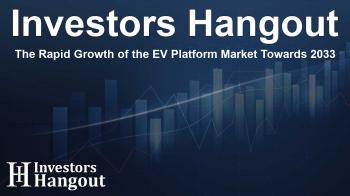The Rapid Growth of the EV Platform Market Towards 2033

The Accelerating Growth of the EV Platform Market
The EV Platform Market is witnessing significant growth, propelled by the increasing global demand for electric vehicles, stringent emission regulations, and the swift adoption of sustainable mobility solutions. Innovations in battery technology, modular vehicle architecture, and lightweight materials are empowering automakers to enhance manufacturing efficiency and extend driving ranges.
Market Projections and Financial Overview
According to recent market analysis, the global EV Platform Market is poised for an impressive expansion, growing at a compound annual growth rate (CAGR) of 15% from 2026 to 2033. The market's valuation was approximately USD 23 billion recently, and it is on track to reach a staggering USD 75 billion by the forecast period's end.
Trends Driving the EV Platform Market
Modular Architectures and Innovation
One of the most notable trends is the shift toward modular skateboard architectures. Automakers are increasingly embracing flat-floor designs that decouple body styles from battery and eAxle systems. This transition shortens program timelines by 20-30%, allowing multiple brands to share underpinnings for enhanced efficiency.
The Influence of Battery Technology
Battery technology continues to evolve, with high-nickel, LFP, and LMFP chemistries coexisting alongside silicon-rich anodes. These innovations are boosting pack energy density and paving the way for structural battery trends, reducing material costs while improving safety standards during crashes.
Software-Defined Vehicle Platforms
As vehicles become more integrated into the digital landscape, software-defined vehicle platforms are gaining traction. These platforms incorporate advanced zone controllers and central computing capabilities, introducing features such as predictive maintenance and fleet telematics, which can add to recurring revenue sources.
Advancements in Charging Technologies
Technological breakthroughs in thermal management and charging systems are also notable. With 800–1000 volt architectures and advanced heat-pump systems, these innovations enhance the performance of fast-charge curves and extend range during colder conditions, improving total cost of ownership (TCO) for both consumers and commercial buyers.
Market Dynamics and Supply Chain Insights
The growth of the EV platform market is not without challenges. Key constraints involve the capacity for graphite and electrodes, lead times for power semiconductors, and the performance of thermal interfaces. Addressing these constraints often involves multi-chemistry strategies and resilient supply chains tailored to accommodate various cell formats.
Furthermore, sustainability practices are being embedded within the manufacturing processes, focusing on traceability for critical minerals and enhancing energy efficiency in production facilities. This foresight anticipates tightening regulations and promotes responsible end-of-life battery management.
Monetization Strategies in the EV Market
Software-defined platforms are creating new monetization opportunities, offering enhancements and subscriptions services that enrich consumer experiences. Commercial clients particularly value uptime and predictable energy consumption, making smart integration with route planning and energy forecasting essential.
Regulatory Environment and Compliance Requirements
As global regulations tighten, industry players must adapt to evolving standards concerning CO2 emissions, zero-emission targets, and cybersecurity protocols. Adhering to these regulations from the outset can significantly reduce approval times and accelerate time-to-market for new products.
Future Directions for EV PlPlatforms
The future of the EV platform market will be shaped by various geographical influences. China, with its robust supplier ecosystem and rapid model launches, is set to continue leading the charge in innovation. Meanwhile, regulatory frameworks in Europe foster demand for efficient and eco-friendly solutions. In North America, growing emphasis on electric trucks and SUVs reflects changing consumer preferences and infrastructure developments.
This dynamic landscape presents opportunities for EV platform manufacturers. Those who harmonize mechanical and digital systems effectively will be positioned to capture significant value, ensuring that they remain competitive within a market progressing towards sustainability.
Frequently Asked Questions
What is the expected growth rate of the EV platform market?
The EV platform market is projected to grow at a CAGR of 15% from 2026 to 2033.
What innovations are driving growth in the EV platform market?
Key innovations include modular architectures, advanced battery technologies, and software-defined vehicle platforms.
What are the regulatory challenges facing the EV market?
Growing regulations concerning CO2 emissions, zero-emission sales targets, and cybersecurity requirements pose significant challenges.
How does battery technology impact the EV platform market?
Advancements in battery technology enhance energy density, reduce costs, and improve safety standards, facilitating broader adoption of EV platforms.
What role does sustainability play in the EV platform market?
Sustainability is central to the industry's future, focusing on traceability of materials, energy efficiency, and responsible end-of-life practices.
About The Author
Contact Logan Wright privately here. Or send an email with ATTN: Logan Wright as the subject to contact@investorshangout.com.
About Investors Hangout
Investors Hangout is a leading online stock forum for financial discussion and learning, offering a wide range of free tools and resources. It draws in traders of all levels, who exchange market knowledge, investigate trading tactics, and keep an eye on industry developments in real time. Featuring financial articles, stock message boards, quotes, charts, company profiles, and live news updates. Through cooperative learning and a wealth of informational resources, it helps users from novices creating their first portfolios to experts honing their techniques. Join Investors Hangout today: https://investorshangout.com/
The content of this article is based on factual, publicly available information and does not represent legal, financial, or investment advice. Investors Hangout does not offer financial advice, and the author is not a licensed financial advisor. Consult a qualified advisor before making any financial or investment decisions based on this article. This article should not be considered advice to purchase, sell, or hold any securities or other investments. If any of the material provided here is inaccurate, please contact us for corrections.

